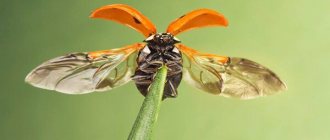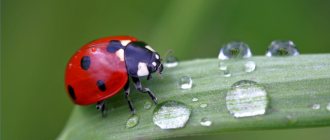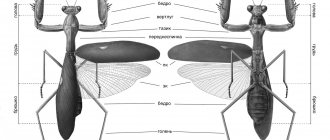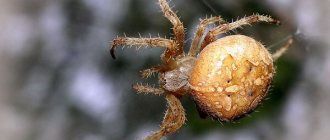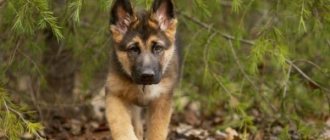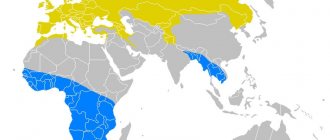Ladybug (lat. Coccinellidae) belongs to the family of beetles, a type of arthropod, a class of insects. When a person sees an insect, he involuntarily has a reaction - to slam it as quickly as possible, but the ladybug evokes sympathy in almost everyone, even women. Some remember a children's song associated with her, others remember that she really helps them out at their summer cottage - saving the garden from pests. What is the secret of everyone's sympathy for this beetle? In some cultures it is forbidden to kill a ladybug, and in the Western part it is generally considered a symbol of good luck. In many countries it is even included in the Red Book. Let's consider the characteristics and lifestyle of this insect, as well as the benefits and harms it can bring.
What does a ladybug look like?
Today, no more than 200 insect formations have been studied on the planet, but the number of species is limitless. The ladybug is a representative of the Coccinellidae family, has over 4000 types and 360 genera, and belongs to the order Coleoptera of the arthropod type. A distinctive feature from other relatives are the seemingly three-part legs. This is due to the small third segment, which is visually hidden with half of the fourth pedicle in the sinus of the bilobed process.
The average size of a ladybug is from 4 mm to 10 mm. The structure of the body is rounded, ovoid, flattened below and convex above. Sometimes the surface is covered with thin fibers.
The head is monolithically connected to the prothorax, everything looks like an enlarged cephalothorax. It makes up the main part of the body length, sometimes found in an elongated oval shape. The eyes are relatively large. The antennae are well flexible and consist of 8-11 segments.
Has rigid expressive elytra. Essentially these are the front flight organs. Over time, the ladybug's wings transformed. On the ground they perform a protective function. With the help of two rear processes, it flies, and it turns out quite well. It is interesting that various birds and many vertebrates do not dare to hunt it not only because of its toxicity. They do not have time to catch it, because the insect makes about 85 strokes per second.
INTERESTING FACTS, INFORMATION
- A ladybug larva eats about 90 adult insects and 3,000 larvae before reaching maturity.
- In Central Asia, there lives a miniature ladybug - a small black beetle, whose length is only one and a half millimeters.
- All ladybugs have approximately the same shape - their bodies are round, highly convex on top and flat on the bottom.
- There is one species of hymenoptera that can eat ladybug larvae from the inside.
- Cows come in stripes and single colors - not all have dots. They differ in color, for example, a two-spotted ladybug can be red with black dots or vice versa, black with red dots.
Why is the ladybug called that?
Where did the ladybug get its name? The question remains open to this day. Scientific terminology is Coccinellidae, the word itself comes from the Latin meaning “scarlet”. Many ethnic groups have their own versions of names, for example:
- among the Germanic peoples - “the bug of the Virgin Mary”;
- among the Anglo-Saxons - “Lady bird”;
- among the Slavic - “Sun”;
- among Latin Americans - “St. Anthony’s cow”;
- among Asians it is “red-bearded grandfather”.
There are long-standing legends about why the ladybug is called that, let's look at some of them.
She was personified with the heavenly herd of Perun, connected the omnipotent gods and mortal people, and was credited with magical abilities to influence the weather. The Catholic faith considered her a messenger of the Mother of God. The British also associate their names with the Virgin Mary.
The ancient Slavs considered her the messenger of the sun. It was impossible to drive away the heavenly creature, so as not to turn away fortune. A beetle that flew into a home was considered to bring peace and grace, so they called it that way - “Sun”. The very word “God’s” symbolized among the Russian ethnic group a trusting believer. The beetle was compared to a harmless creature.
But more likely the word “lady” is associated with a physiological feature of the insect. It secretes milk, but it is far from usual - a red aggressive liquid formed in the spores of the limbs. The discharge is extremely unpleasant and in large quantities is deadly for those who decide to eat it. And another similarity with a cow is the presence of spots on the body.
Where does this name come from?
The question of why the insect got its name still remains open. There are several versions:
- The arthropod was called “cow” either for its ability to secrete so-called “milk”, or for spots on its body reminiscent of the colors of many breeds of cows;
- The insect was awarded the epithet “ladybug” for helping people preserve crops; in addition, despite the fact that in nature it is a rather dangerous predator, among people the ladybug is valued for its harmlessness and gentle disposition.
There are other options for the origin of the name. For example, the ancient Slavs associated a bright bug with the goddess of fertility.
Types of ladybugs
The ladybug is not necessarily red, but its coloring is in the form of dots. The dots may be absent altogether, and instead of them, stripes, patterned spots, or comma-shaped spots may appear on the shell. The most common type is the seven-spotted beetle. It lives almost throughout Europe, its dimensions reach 7 mm, the elytra are burgundy, there are two light-colored spots at the base, one dark one can be seen on the pronotum, with speckles on the elytra.
They are also divided according to the number of dots and color:
- two-spotted, usually 5mm dark scarlet individuals with 2 large black markings;
- twelve-pointed up to 6 mm, have pinkish elytra, on which 6 pieces are observed;
- thirteen-spotted up to 7mm, with brownish wings;
- fourteen-spotted - with a yellow color and black spots on them or vice versa;
- seventeen-point identical colors ranging from 2.5 to 3.5 mm;
- variable, with a black pre-back with 2 brownish spots, contrasting markings at the base of the yellowish-red elytra;
- blue ones are found on the Australian mainland and have a beautiful tint of blue and green tones;
- white or light gray - up to 15 marks, less common, like brown plain ones.
Give up chemistry
Pesticides do not differentiate between good and bad insects; they kill them all. If you have previously treated the plants with chemicals, ladybugs will definitely not land on them.
Once you have attracted beneficial insects, you can encourage them by periodically feeding them with a homemade liquid food solution. Mix equal parts water and brewer's yeast with a little honey and spray throughout the garden. Pour the solution into an aerosol can and spray it onto the surface of the plants.
Bright warning coloration of a ladybug
The ladybug is endowed with bright colors, which help in the struggle for existence and strike fear into enemies, most often birds. This is one example of mimicry, like the green color of grasshoppers, or the ability of a chameleon to blend into its environment for the purpose of self-preservation.
The striking colors of the natural wild world serve as warning signals about the toxicity and inedibility of the observed prey. There is a theory that the brighter the color of the beetle, the less likely it is to be attacked by enemies. The expressive color of various types of ladybug indicates mortal danger. It may fade with age.
Care and caution
The ladybug is small (an adult reaches an average of 0.8−1 cm) and fragile, so any attempt to pick it up or play with it can lead to negative consequences. Precautionary and careful measures when caring for a bug are the following:
- It is better to catch the animal with a net.
- In order to take an insect in your hand, you need to place your finger next to it and wait for it to climb onto it.
- The ideal temperature for life and reproduction of Coccinellidae is considered to be +20 ⁰ C, so it is recommended to avoid hypothermia.
Do not forget that your pet is an insect, so after each contact with it it is recommended to wash your hands thoroughly with soap.
Where do ladybugs live?
Ladybugs live almost all over the world, except in northern latitudes. Their life cycle depends on the availability of food. The active stage occurs during the extermination of aphids, the main diet of these insects, i.e. from spring to autumn. They live from a couple of months to one year, and occasionally last up to two. Able to survive winter in foliage or under the bark of trees.
A solitary lifestyle is acceptable to them; they settle in groups for wintering or for mating. They feel comfortable in open areas with grassy vegetation on forest edges, steppes, meadows and gardens.
In search of food, they crawl through plants, periodically flying over long distances. They do this easily, silently, working all day, destroying pests. Cows are thermophilic, the optimal temperature for them is +10 C and above; during other periods they spend the winter.
Population and species status
Photo: Ladybug
The population of ladybugs has decreased significantly due to active control of aphids. These little bugs simply have nothing to eat. Due to rapid reproduction and a small number of natural enemies, the population is able to recover in a short period of time if food is available. The status of the species is currently stable. At this time, only some rare varieties of these beetles are under threat of complete extinction, for example, the Australian blue and pointless ones.
Interesting fact: In search of food, a hungry ladybird larva can travel up to 12 meters, which is a huge distance for insects.
Trying to restore the population of beneficial bugs artificially, people sometimes, even with their good intentions, on the contrary, cause significant damage to it. In recent years, millions of individuals, specially bred ladybugs, have been released into their natural habitat, which, due to obvious mutations, changed the nature of their feeding and chose their own relatives as victims. All this caused the death of a huge number of beneficial bugs in all European countries. A thoughtful approach to this problem is needed without undue interference in the natural course of processes in nature.
How and where do ladybugs overwinter?
When cold weather sets in, sedentary varieties of ladybirds gather in large groups, sometimes up to millions of individuals. In winter, they look for secluded places, hiding under the remains of falling leaves, dry wood, stones, where they wait for the arrival of warmth. They can fly indoors, hide between window frames, folds of curtains, and arrange nesting sites among trees.
There are species of beetles that fly away in flocks to winter in southern latitudes. Recently, features of adaptation to the environment have become not only bright colors or toxic liquid released when dangerous. Their group aggregations are becoming more and more observed. This is still inexplicable, but the spectacle is colorful.
If you find a “sleepy colony” of cows, do not disturb them and bring them home to warm them up. Think about how many pests they will be able to kill in the future. Move them to a comfortable place where no one will crush them, let them calmly complete their hibernation.
Features of character and lifestyle
Photo: Red ladybug
All varieties of ladybugs choose an isolated lifestyle and form groups only for flying to warm regions or wintering in a secluded place. These huge groups can number up to 40 million individuals. You can also notice clusters of bugs during their mating season. All these bugs do not hesitate to feast on the larvae of their relatives, but only in the absence of a sufficient number of aphids and other food. But there are varieties of ladybugs that purposefully destroy their fellow creatures.
Interesting fact: The yellow marbled ladybug was specially bred as an effective biological weapon against agricultural pests, but it was because of it that some varieties of these bugs were in danger of complete extermination, since the marbled ladybug destroyed them in huge quantities along with other insect pests .
These insects are active all day, they slowly crawl from one plant to another in search of food. Given enough food, the lifespan of some individuals can reach two years or even more, but this happens extremely rarely. The main part dies much earlier, before reaching the age of one year, and there are many reasons for this: from lack of nutrition to environmental pollution.
What do ladybugs eat? Are they predators?
A characteristic feature of insects of the order Coleoptera is the gnawing type of mouthparts. The ladybug has similar anatomical characteristics. The structure of the digestive system begins with the mouth and ends on the abdomen with the anus. The intestinal canal runs between them. This allows the insect to consume complex molecular food with a high energy reserve when feeding.
Simply put, the coccinellid is a predator; it eats its own kind. Diet preferences are given to:
- aphids;
- spider mites;
- small caterpillars;
- eggs of butterflies, Colorado beetles;
- larvae of insect pests.
There is also a species that feeds on plant foods: pollen, flowers and leaves, mycelium, and fruits.
Nutrition
These peaceful creatures for humans are very dangerous for living organisms of their size and type and are voracious predators. But even with their carnivory they bring considerable benefits to humans. After all, those whom they eat are known as malicious pests and parasites.
What do ladybugs eat ? They destroy hordes of aphids (an adult can eat about a hundred of them in a day), eat other insects, their eggs, as well as caterpillars, pupae and even butterflies.
Therefore, in order to save farmland, ladybugs are deliberately bred and dropped from airplanes in large numbers. If they lack food, they happily turn to the eggs of a well-known pest of potato plantings - the Colorado potato beetle.
But there are species of these insects whose diet includes only plant foods: flowers, leaves, pollen, and in some cases, plant fruits and mushrooms. They really sometimes become a big problem, causing damage to fields and crops growing on them.
However, such species are more common in southern Asia. In Russia they exist (for example, alfalfa and pointless ladybugs), but they are not common.
Some classify this insect as a pest only because they confuse it with others. For example, there is an insect that looks like a ladybug . This is epilyakhna. It eats potato tops and harms tomatoes, pumpkins, corn, and cucumbers.
There are pests similar to the ladybug, epilyachna
It is also called the potato ladybug. It differs from the described insects in the dull colors of its outfit, the abundance of spots (there are as many as 28 of them), and upon closer examination you can see thin whitish hairs on the body.
Reproduction of ladybugs
Ladybugs reproduce several times a year, in spring or autumn. In temperate latitudes this is the beginning of May. The female becomes sexually mature at the age of 3-6 months. As a rule, after a cold period, she is able to emit a pungent odor that attracts males.
The female places eggs on vegetation with an abundance of aphids, providing food for future offspring in advance. They have an elongated shape, narrowed towards the end, and are colored yellowish-orange. One clutch can number from several to 400 pieces, arranged in even rows, close to each other. Sometimes they can be eaten by their own relatives, the so-called cannibal larvae.
WHERE IT IS FOUND
Ladybugs can be found throughout the year (for example, if you dig up the dry leaves under which they hide during the cold season), but you can see them without making any effort only in spring, summer and early autumn. In winter they hibernate. At this time of year, entire groups of ladybugs protect themselves from the cold in secluded places, for example under the bark of a tree. In summer, they can most often be found on roses, cherries and other garden plants affected by aphids. Taking a closer look at the plants, you can see the testicles of ladybugs. Ladybug larvae live openly on plants. In winter, you can find the seven-spotted ladybug among the needles of coniferous trees.
Ladybug larvae - what do they look like?
Further development occurs over 4-7 days and has several stages. The larvae are oval in appearance. They look colorful due to yellow-orange spots that form a certain pattern. Body surface with bristles, peculiar outgrowths. Newborn ladybugs that feed on scale insects are covered with whitish, waxy threads. Everything grows in 2-4 weeks.
After this stage comes the moment of pupation. To move into it, the individual attaches the back of the body to the leaf plate and curls into a semi-bent position. At the end of the internal transformation, the skin peels off the pupa, sliding like a stocking to the end of the abdomen. It does not lose its bright color with black and yellow specks. Next, from 7 to 10 days, an adult is formed.
Lifestyle
Ladybugs prefer to live “alone”, apart from other representatives of the species.
Only during the mating season do they come together to continue their family line. They also gather together for flights and wintering.
A ladybug can be called a fruit-loving bug, therefore, with the onset of a cold period, all insects living in temperate latitudes gather together and fly away to warm countries.
Among insects there is a sedentary species. They do not fly to countries with hot and dry climates, but gather in one place and winter in huge communities, reaching 400 million adult individuals. If you calculate how much such a “ball” weighs, you can get a figure equal to several tons.
To shelter from unfavorable climatic conditions, the “suns” hide in the ruins of stones and also take cover under fallen leaf blades of shrubs.
Under good conditions and the availability of food, spotted insects can live for 1 year. Under unfavorable conditions, the lifespan of insects does not exceed several months.
The benefits and harms of ladybug
The boundless gluttony of this predatory beetle brings great benefits to homesteads and agricultural crops, because it eats aphids that harm the crop. While in the larval stage, the coccinellid consumes up to 50 prey per day. An adult insect eats up to 100 aphids. They help plants by clearing crops of pests. Therefore, they are even bred at specialized enterprises, and then distributed over the fields with the help of aviation.
But harm can be caused by herbivorous species of these beetles; their habitats are in Asia. There they cause significant damage to crops. In our area, some harm vegetables: potatoes, sugar beets, tomatoes and cucumbers.
Description
These beetles from the order Coleoptera are found in almost all climatic zones of the world. There are almost 4,000 species on the planet; 221 species of these insects live in our country alone.
Ladybugs vary in size, body shape, elytra color and number of spots. Thus, shades can vary from yellow and orange to poisonous red. These bright colors provide protection to the insects from birds of prey and other insects.
Contrary to popular belief, the number of dots on the wings does not depend on the age of the beetle, but only on the species.
The lifespan of a ladybug is 1 – 2 years. During this time, the insect goes through 4 stages:
- egg;
- larva;
- chrysalis;
- and imago - an adult insect.
During the spring and summer, the ladybug eats, accumulating reserves for wintering.
With the onset of cold weather, it hibernates, and in the spring, those individuals that were able to survive the winter lay 1–2 dozen eggs and die before the hatching of a new generation. The scientific name of the ladybug sounds like “Coccinellidae”, or “Coccinellidae”, but much more often this useful insect for the gardener is called differently: “St. Mary’s beetle”, “St. Anthony’s beetle”, “Sun”. And in Tajikistan they respectfully call him “Redbeard Grandfather.” These names best show how much gardeners value this colorful bug.
How do they reproduce and are born?
Insects reach sexual maturity at approximately 3–6 months of life (depending on the species).
Their mating season begins with the arrival of spring. The female produces a characteristic odor, thanks to which the future chosen one finds her. Next, mating occurs, and the female lays eggs (most often near colonies of parasites to provide food for the offspring).
The eggs are oval in shape with slightly tapered ends. Color - yellow-orange. In one clutch, the female manages to lay about 400 eggs. After 1–2 weeks, the larvae are born.
The ladybug goes through the following stages of development:
- The insect larva remains in this state for 1–2 months.
- The pupa attaches itself to the grass and spends 7–10 days in this position. It is during this period that the necessary parts of the body are formed.
- An adult lives from several months to 1–2 years.
Stages of ladybug development
By the fifth month of life, most insects of this species reach sexual maturity. Ladybugs actively breed already in April. The bugs gain strength after hibernation and only then begin to mate. The ladybug feeds especially intensively at this time to produce healthy offspring.
Thanks to the specific aroma, the male easily finds the female. The eggs are laid near aphid colonies so that in the future the young ladybug can fully feed (what the insect eats was described above). Typically, eggs attach to the underside of plant leaves.
One female can lay up to 400 eggs, then she dies.
After just a few eggs, bright ladybug larvae emerge from the laid eggs. What is an insect? From the first days of life, the larva can feed on aphids and pieces of plants.
The larvae can also eat the shell of the egg from which they hatched. Of the many eggs laid, not all of them fully develop; some of the embryos die.
Mature larvae can also feed on these remains.
From the moment the larva appears until the full-fledged bug matures, at least a month passes. The larva pupates, and a week later a normal ladybug is born. What does a young insect eat? It all depends on the species. If it is a predator, then it will continue to feed on aphids and mites.
Red Book
The ladybug has long been listed in the Red Book not only of Russia, but of the whole world. The number of individuals has sharply decreased due to the massive destruction of aphids, which led to the disappearance of the main food source of this insect.
This beetle is one of the most ancient insects on earth. The “law” protects it from extermination, since this insect is extremely useful in agriculture.
Sources
- https://www.poznavayka.org/zoologiya/bozhya-korovka/
- https://animaljournal.ru/article/bojya_korovka
- https://konohovo.ru/stati/chem-pitaetsya-bozhya-korovka-v-prirode.html
- https://protarakanov.ru/bozhya-korovka.html
- https://posevsado.ru/chem-pitaetsja-bozhja-korovka-v-prirode.html
- https://WikiParazit.ru/zhuki/bozhya-korovka-vidy-opisanie.html
- https://aquarium-fish-home.ru/nasekomye/bozhya-korovka-nasekomoe-vidypitanierazmnozheniefotovragiopisanie/.html
- https://zhivotnyeplanety.ru/bozhya-korovka/
- https://2516826.ru/kleshchi/kak-uhazhivat-za-bozhej-korovkoj.html
- https://TaraKlop.ru/zhuki/chto-edyat-bozhi-korovki/
- https://protarakanov.ru/chem-pitayutsya-bozhi-korovki.html
- https://www.m-sokolov.ru/2016/07/07/coccinellidae/
- https://chtoedyat.ru/chto-edyat-bozhi-korovki/
- https://gkd.ru/444094a-chto-est-bojya-korovka-mesto-obitaniya-pitanie-razmnojenie
- https://NatWorld.info/zhivotnye/fakty-o-bozhih-korovkah
- https://bioros.net/nasekomye/bozh-ya-korovka-opisanie-vidy-chem-pitaetsya-interesnye-fakty.html
[collapse]
